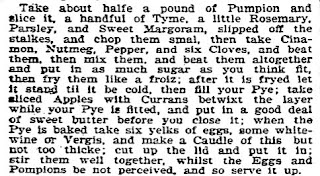

I can’t be the only person who is haunted by a recipe.
I saw this little beauty a few years ago. It was in a November 27, 1895 NYT's article that included 'modern' Thanksgiving menus as well as fashions of times past. It was said of this pie that it "puts the modern pumpkin pie to blush for the simplicity of its construction. It gives evidence that the early American Thanksgiving day did not pass without some culinary pomp and display". How could I not want to make this pumpion pye? Before that could happen, a little translating was in order. I knew vergis was probably verjuice and remembered that caudle was a restorative egg noggy drink. I looked up the obscure froiz but had no luck. I was stuck on froiz which was a fairly elemental part of the recipe. No pumpion pye for me.
Luckily times have changed. This year I found the source thanks to an inspired online library system, Project Gutenberg. After about 5 Google searches i found that the original came from the 1656 The Complete Cook, published by Nathaniel Brook, authored by W.M., but there was a nearly identical recipe a few years later in Robert May’s 5th edition (although it was first published in 1665) 1685 The Accomplisht Cook:

Now, you can see the problem right away. My old version says ½ pound of pumpion, Robert May's version says 1 pound. All common sense tells me 10 eggs for ½ pound of pumpkin is overkill. Even though my encounters with now odd Elizabethan the-more-the-merrier spicing had made me feel anything was possible… I was pleased that intuition won the day.
Not all things are wonderful about making an antique dish. Let's talk about pie crust...or paste. I substituted my own pie crust when I read this in May’s book:
To make a Paste for a Pie.
Take to a gallon of flour a pound of butter, boil it in fair water, and make the paste up quick
During the English Renaissance, much food was prepared in pastry 'coffins' (a Charles Addams image if ever there was one), created to contain the interior ingredients during the cooking process with a casket-like sureness. The crust had to have a ceramic durability. This was not going to be the tender flaky stuff that we spoiled moderns have come to expect. I chose to try the paste another day... perhaps with a nice 16th century 'chickin pye'
Although this recipe seems alien and is quite a departure from our modern pumpkin pies with creamy fillings, the layers of the dish are not unlike, say, eggplant lasagna where you must cook the eggplant first in an egg dip and fry before layering it with sauce and pasta. According to Mr. Johnson's 1825 dictionary, "froise" comes from the French "froisser, as the pancake is crisped or crimpled in frying. The froiz is like a omelette/pancake with sliced up pumpkin and wonderful spices and herbs. The layers of apple and currants and the froiz sounded bizarre but were quite good in the end. I made a little lid, inspired by some of the engravings in May’s book so it would be easy to pour in the caudle (wine or liquor and eggs made into a drink) after baking was done. I was pleased to have some verjuyce on hand(not the crabapple juice that the English may have used but a wonderful Madeleine Kamman recipe with honey and cider vinegar and Armagnac.)
Thanks to Tastespotting for publishing my pumpion pie post!!!


0 comments:
Post a Comment